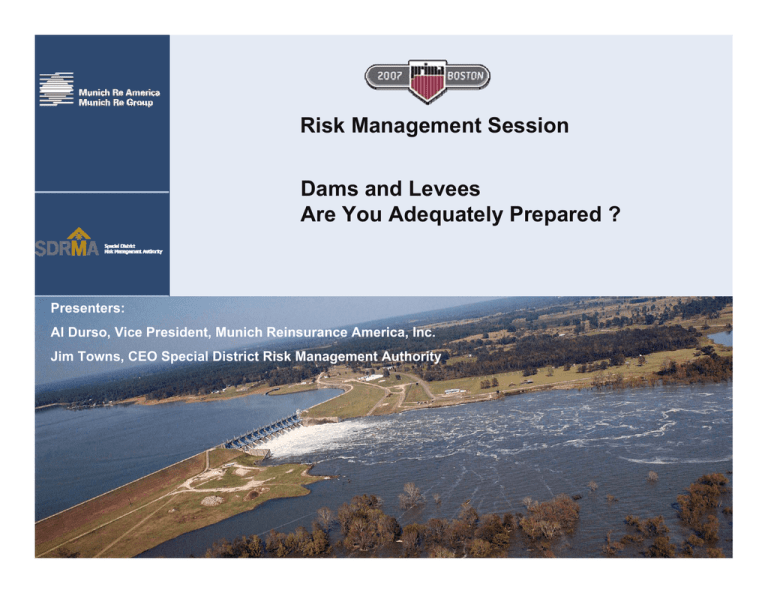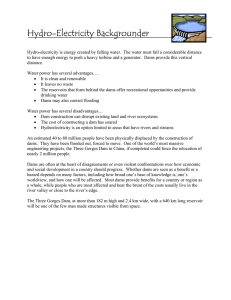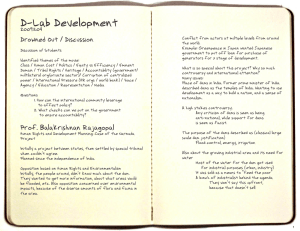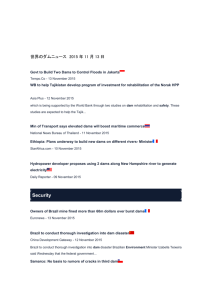Dams - sdrma
advertisement

Risk Management Session Dams and Levees Are You Adequately Prepared ? Presenters: Al Durso, Vice President, Munich Reinsurance America, Inc. Jim Towns, CEO Special District Risk Management Authority Session Overview Dams and levees provide tremendous benefits including water supply for drinking, hydroelectric power, flood protection and recreation. At the same time, they can also represent a great risk to public safety, property and local economies. Objective To provide conference attendees with underwriting criteria and processes for both the insurer/reinsurer (seller) and the pooled agency (buyer) to the risk associated with dams and levees: Identify underwriting criteria, processes and risks Develop risk standards Establish evaluation methods to minimize potential losses 2 Introduction Dams have multiple purposes including recreation (31%), fire and farm ponds (17%), flood control (15%), irrigation (14%), water supply (10%) and other uses. 79,000 dams listed on the National Inventory of Dams http://www.crunch.tec.army.mil/nid/webpages/nid.cfm Approx. 22,000 dams owned by local and state government (21.8% and 6%), and 66.3% private According to the American Society of Civil Engineers (ASCE) since 1998 the number of unsafe dams has risen 33% to more than 3,500 Photo source: US Department of the Interior 3 Introduction Levees are embankments raised to prevent a river from overflowing and are the oldest, most extensively used method of flood control throughout the U.S. The most extensive levee systems are along the Mississippi and Sacramento Rivers. 1,519 miles of levees in Mississippi – most notable levee breach August 2005 with Hurricane Katrina resulting in $2560B in losses (9/11 losses $36B) 1,600 miles of levees in California – most notable levee breach February 1986 Linda Levee resulting in $1.5B in losses. Photo: California Department of Water Resources 4 Some Potential Causes of Failures Dams Levees Overtopping Inadequate inspection and Structural failure Cracking caused by movement (settling and earthquakes) Inadequate maintenance Piping failure Lack of funding maintenance Lack of funding Seepage (boils) caused by rodents and decayed tree roots Erosion Overtopping Earthquakes 5 The Results of Failed Dams and Levees Fargo, ND - 2001 Yuba County, CA - 1986 Photo: US Army Corps of Engineers Permission to reprint from Costa County Historical Society in Martinez, CA, Photo: US Dept. of Defense New Orleans, LA - 2005 6 Scenes from New Orleans Following Katrina Texas Army National Guard UH-60 Black Hawk (Blackhawk) helicopter flies over a flooded New Orleans, Louisiana (LA), while dropping sandbags on a breached levee, during relief operations. Photo: US Department of Defense “For Sale – Needs Some Work” Photo: Jim Towns 7 Underwriting Considerations As our nation’s infrastructure ages, combined with the effects of Katrina, there is a heightened interest in the topic of underwriting the casualty exposure of dams and levees. It is important to understand, consistently evaluate and price adequately to the potential risk associated with dams and levees. 8 Underwriting Considerations - Dams Type of construction, material used, method of construction The way the dam resists the forces of the water pressure The means used for controlling seepage Age Intended purpose of the dam Operational history: inspection and maintenance, safety violations and failures Funding/budgeting – who pays to maintain? Hazard rating (downstream exposure, inundation reports) – most critical! Terrorism – target? 9 Underwriting Considerations - Levees Type of construction and material used Length and Height Agency(s) responsible for regulations, operation and maintenance Age Operational history: inspection/maintenance schedule, safety violations and failures Reparability 122 U.S. levees “at risk of failing” per Army Corp of Engineers 2/5/07 Funding/budgeting – who pays to maintain? 10 Sample Hazard Ratings Low Hazard A dam or levee located in an area where failure will damage nothing more than isolated buildings, undeveloped lands, or township or county roads and/or will cause no significant economic loss or serious environmental damage. Moderate Hazard A dam or levee located in an area where failure may damage isolated homes, main highways, minor railroads, interrupt the use of relatively important public utilities, and/or will cause significant economic loss or serious environmental damage. High Hazard A dam or levee located in an area where failure may cause loss of human life, serious damage to homes, industrial or commercial buildings, important public utilities, main highways or railroads and/or will cause extensive economic loss. 11 Recommended Underwriting Information Secure inspection report verifying all dams and levees have been inspected within last 36 months. Verify all critical recommendations for prior inspection reports have been complied with. Secure supplemental underwriting application for any risk with a high-hazard dam. Secure copy of Emergency Procedure / Plans for any risk with a high-hazard dam to ensure and document existence of such procedure/plan. Secure historical claim information on all dams and levees – past 5-10 years. Secure proximity of all dams and levees within the risk sufficient for underwriter to identify potential accumulation of exposures which may lead to multiple breaches in one event. Satellite Mapping Tools like Google Earth can help. 12 Underwriting Resources LOCAL FEDERAL STATE 13 Underwriting Resources Federal Agencies • Federal Emergency Management Agency (FEMA) http://www.fema.gov http://www.floodsmart.gov/ http://www.fema.gov/emergency/nims • Army Corp of Engineers http://www.usace.army.mil/cw/cecwhs/em/fcw/lom/lom.html • Federal Energy Regulatory Commission (FERC) http://www.ferc.gov/industries/hydropower/safety/guidelines/fema-93.pdf 14 Underwriting Resources State Agencies • Office of Emergency Services • Department of Water Resources (Division of Safety of Dams) • Reclamation Board Local Agencies • Dam/Levee Owner • National Performance of Dams Program http://npdp.stanford.edu/index.html • National Inventory of Dams http://crunch.tec.army.mil/nidpublic/webpages/nid.cfm 15 Underwriting Resources Other • Local Newspapers • National Fire Protection Association (NFPA) http://nfpa.org 16 Emergency Action Plan – NIMS Standards On February 28, 2003, the President issued Homeland Security Presidential Directive (HSPD)–5, Management of Domestic Incidents, which directs the Secretary of Homeland Security to develop and administer a National Incident Management System (NIMS). • This system provides a consistent nationwide template to enable Federal, State, local, and tribal governments and private-sector and nongovernmental organizations to work together effectively and efficiently to prepare for, prevent, respond to, and recover from domestic incidents, regardless of cause, size, or complexity, including acts of catastrophic terrorism. • The directive also requires Federal departments and agencies to make adoption of the NIMS by State and local organizations a condition for Federal preparedness assistance (through grants, contracts, and other activities) beginning in FY 2005. 17 Emergency Action Plan – NIMS Standards Recommended Standard NIMS Components NFPA 1600 Preparedness • Preparedness hazard and risk/vulnerability assessment. • Hazard mitigation strategy (inundation report). • Resource management planning and objectives. • Mutual aid planning. • Emergency operations and control planning. • Public awareness and communications planning. • Financial planning. NFPA 1561 Communication and Information Management • Communications systems. • Management and control of communications systems. Topics Covered 18 Emergency Action Plan – NIMS Standards Recommended Standard NIMS Components NFPA 1600 Communication and Information Management • General communication systems procedures. • Public awareness and communication. NFPA 1600 Resource Management • Resource management and mutual aid planning. • Listing of additional mutual aid resource to consider. NFPA 1600 Command and Management • Program management. • Advisory committee for interagency coordination. • Program evaluation. • Essential program elements to command and management. • Business continuity issues. Topics Covered 19 Emergency Action Plan – NIMS Standards Recommended Standard NIMS Components NFPA 1561 Command and Management Topics Covered • Risk assessment and management in incident command functions. • Incident accident plans. • Accountability. • Emergency management and control. • Command and general staffing. • Incident command functions. • Multi-agency coordination. • Multi-agency involvement and coordination. 20 INCIDENT COMMAND SYSTEM (ICS) EXPANDING SYSTEM 21 Thank you for your attention . . . Hasta la Vista Baby Photo: Office of the Governor of California The Governator The material in this presentation is provided for your information only, and is not permitted to be further distributed without the express written permission of the presenters. This material is not intended to be legal, underwriting, financial, or any other type of professional advice. Examples given are for illustrative purposes only. The Munich Re America name is a mark owned by Munich Reinsurance America, Inc. 22




